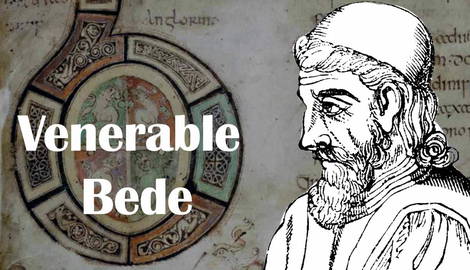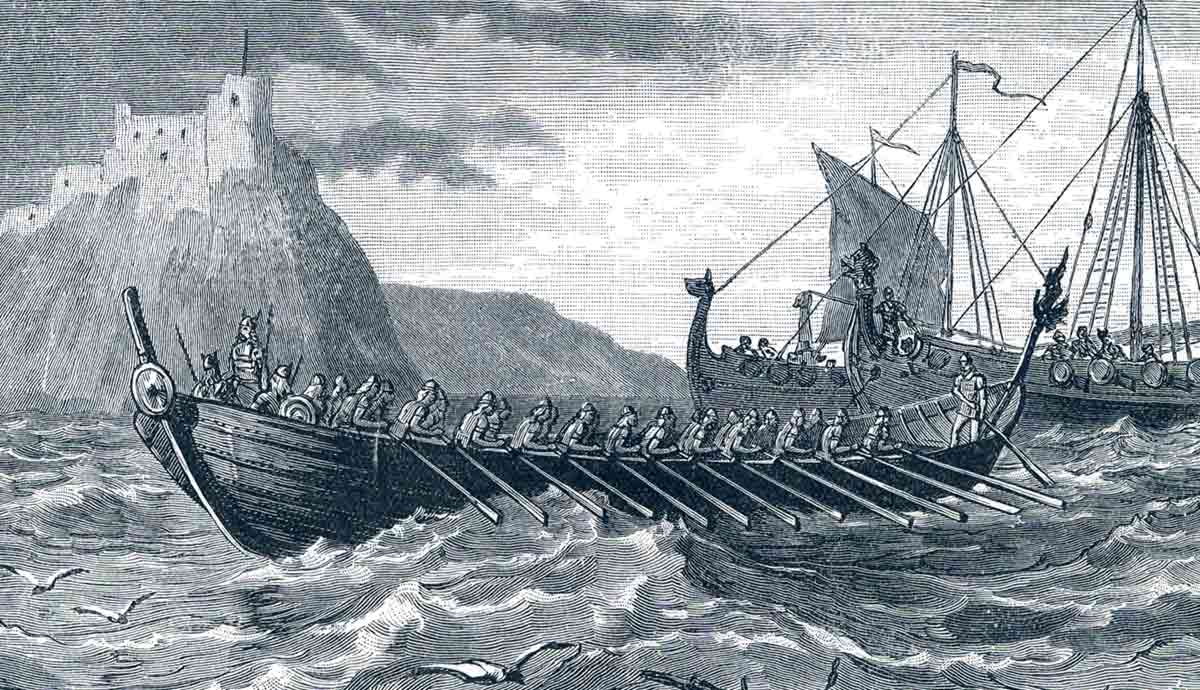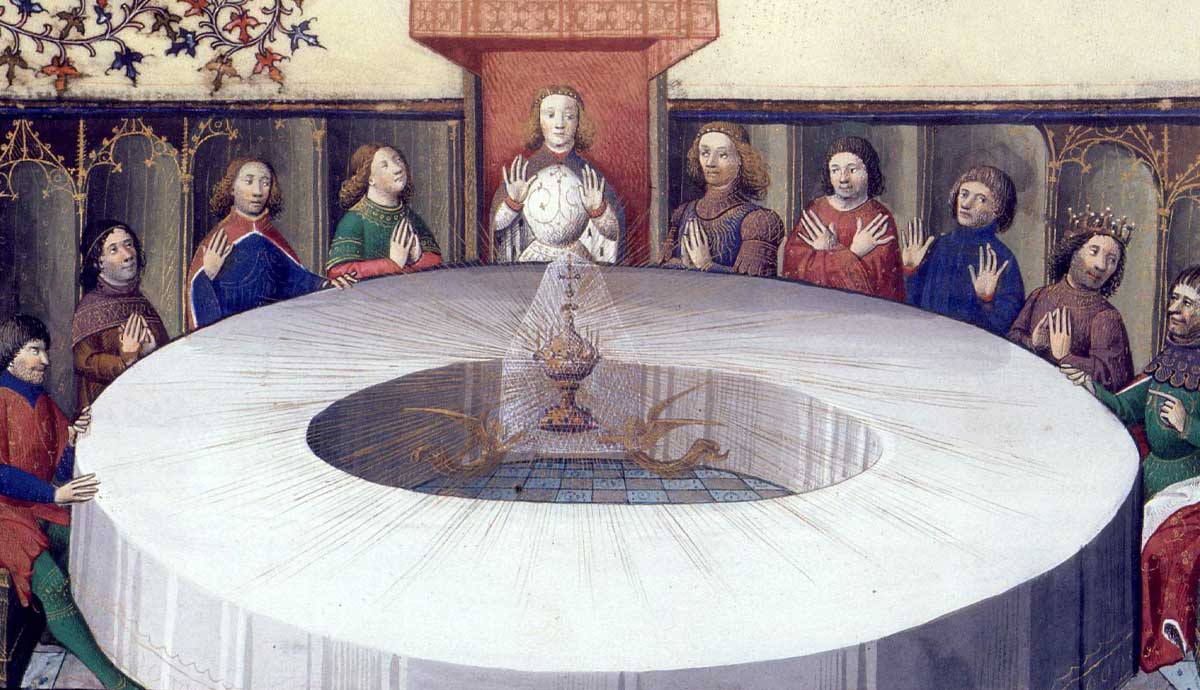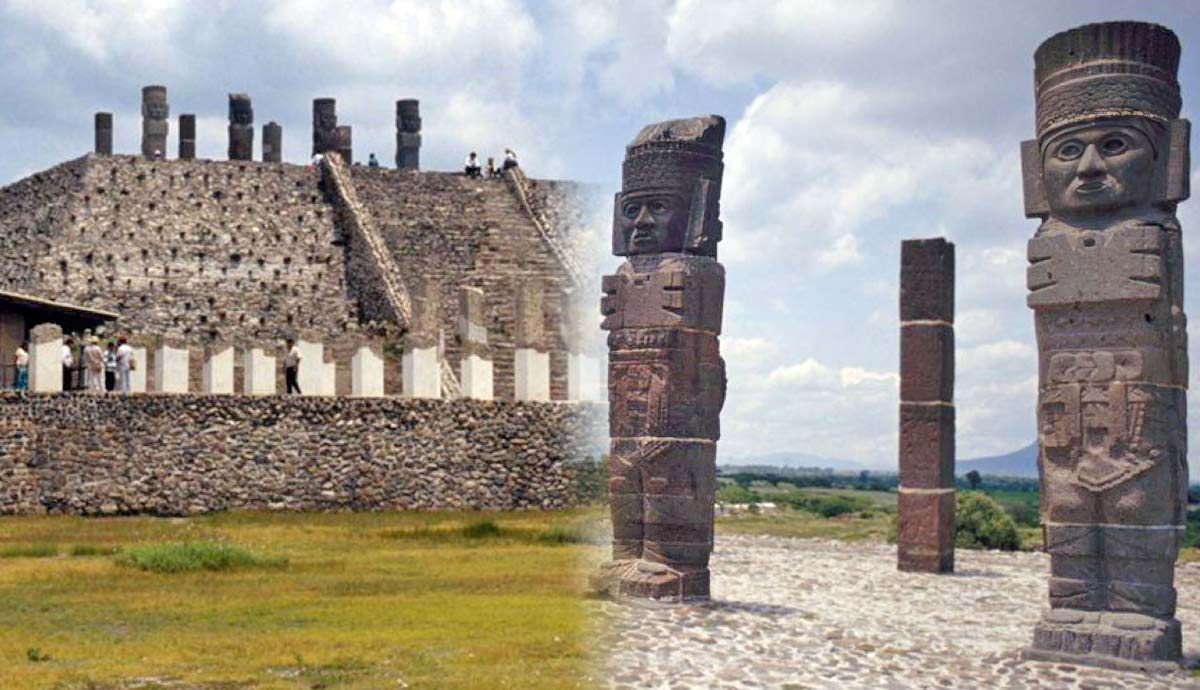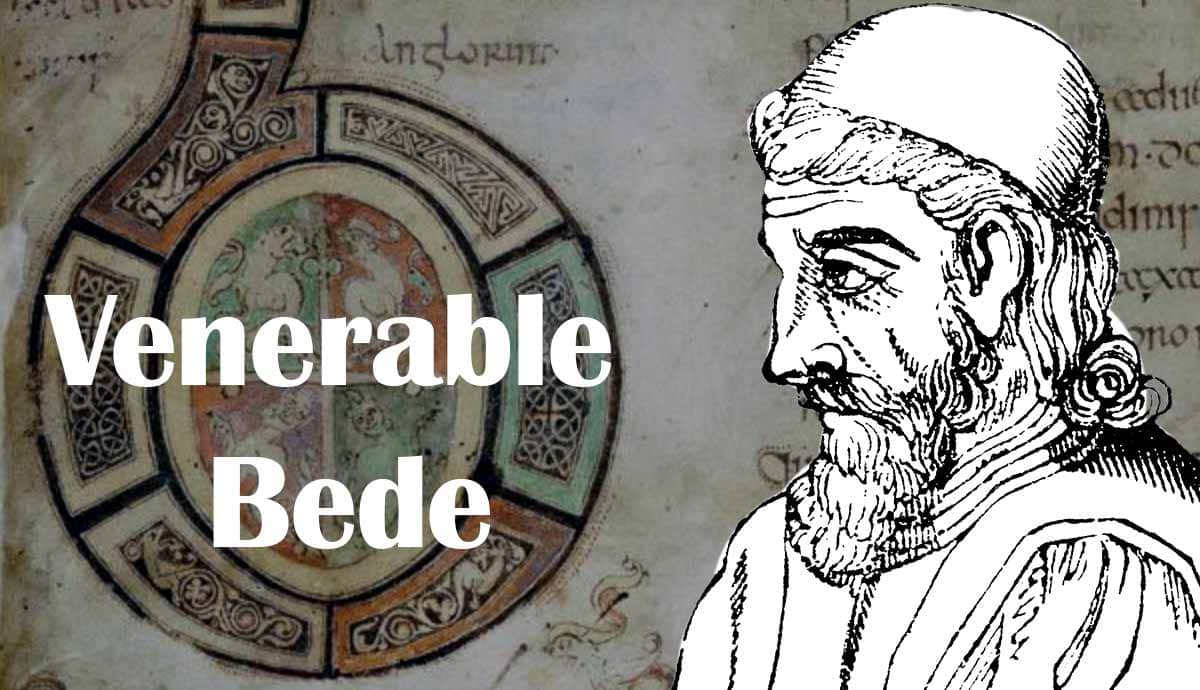
Bede is remembered today chiefly as a historian. Yet he was a dynamic intellectual giant in the Early Middle Ages and his most famous historical work is far more than a dry recounting of events. Let us explore Bede, his History, and the influence that it has had.
Northumbria in the Age of Venerable Bede

Bede is frequently labeled as the father of English history. As we will see, he had a clear conception of an “English people” living within the British Isles. Yet the Anglo-Saxons were at this time split into various kingdoms. Bede was from Northumbria, the kingdom encompassing the northeast of modern England and the southeast of modern Scotland, which was itself internally composed of a southern realm called Deira and a northern realm, Bernicia.
In the late 7th and early 8th century, the kingdom of Northumbria was in the middle of a golden age. Though in the European sense a backwater, the kingdom was producing art, texts, and people that are still at the core of the modern northeastern identity. It was a world in which Christianity, a relatively new religion among the Anglo-Saxons, was spurring new forms of expression and thought, centered on the monastic institutions being founded there. Bede was born into this world, in around the year 673. But to understand Bede and his world it is apt to begin with the life of another monk of the northeast.
St Peter’s church in Wearmouth, on the site of one of the twin monasteries founded by Biscop. Source: National Churches
Benedict Biscop founded the monasteries of Wearmouth and Jarrow, where Bede would spend his entire adult life. Biscop was born in around 628 and after deciding to become a monk he traveled frequently to the continent where he soaked up the culture of the Roman Church. Biscop became determined to infuse continental Christianity into a monastic foundation of his own. Thus he imported stonemasons from Francia to build his monastic house in the 670s and brought over books, relics, calendars, and people from the continent to fill the monastery.
Biscop founded the monasteries of Wearmouth and Jarrow, around 10 miles apart, as joint houses and they would remain conjoined through the time of Bede. Most of what we know of Biscop comes from the account of his life written by Bede himself, and it seems clear that Bede held Biscop in great reverence, for Bede’s ability to become the intellectual giant that he was rested on foundations laid by the founder of his monastery.
Northumbria was also home to the monastery of Lindisfarne, which was one of the most renowned Christian houses in all of Europe. Lindisfarne was associated with the monks Aidan, its founder, and Cuthbert, two deeply influential holy men whose aestheticism and reported miracles resounded across Christendom. The Lindisfarne Gospels, a richly decorated manuscript, was made on the island monastery in around 700 and remains one of the most revered pieces of art from early medieval Europe.
Thus although Bede grew up in the remote northern reaches of an obscure island off the European continent, Northumbrian Christian centers were flowering in his time. He was part of a sophisticated religious and intellectual community that spanned across Europe, even though there is no evidence that he ventured far from his monastery in Northumbria at any time in his life.
Bede and His Ecclesiastical History

Bede himself tells us the few details we know of his life. He entered the monastery of Wearmouth-Jarrow at the age of seven, in around 680. Plague swept through the monastery in 685, leaving a young Bede as one of the few survivors, though the community soon revived. He noted being ordained a deacon at the age of 19 and a priest at 30. For the most part, Bede is a mystery to us, despite being by far the most prolific writer of his time in the British Isles.
To access Bede we must turn from the sparse biographical details we have and look at the works that he left behind. By far his most famous work, and that which has earned him his title as “the father of English history,” is his Historia Ecclesiastica Gentis Anglorum, or Ecclesiastical History of the English People. Marc Morris in his book The Anglo-Saxons labels this as “without question the single most important and influential work of the whole Anglo-Saxon period.”

The work constitutes a history from the time of Caesar’s invasion up to around 731, the year in which he completed the text. Yet Bede does not attempt to write a meticulous account of every noteworthy event in between these dates. History as we understand it, the modern scholarly discipline, was alien to this period. A work of history would always have a purpose beyond the accurate recording of events, a certain narrative that the author sought to put forward. For Bede, his work portrayed the Anglo-Saxons as a people chosen by God to become converted to Christianity and brought into the fold of the universal church. The coming of the Anglo-Saxons to Britain, their conversion to the Christian faith, and the establishment of the Roman Church in their kingdoms are the core of Bede’s narrative.
Bede himself in a preface to the Ecclesiastical History, dedicated the work to King Ceolwulf of Northumbria, and stated that history was important in allowing people in the present to imitate the good actions of good men of the past. He thought that this was especially so when history focused on “men of our own race” — thus his work was in many ways intended to be instructional, containing local stories to help guide people toward actions that carried divine approval. His desire to embed local stories and fables into his narrative can often make his work difficult for modern readers to interpret when searching purely for historical facts.
The Content of the History

Part of what makes Bede’s Ecclesiastical History so important is that it provides a detailed account of a period of history in Britain where there is an otherwise severe lack of sources. Though Bede certainly had a particular narrative in mind, he did not neglect to provide details of important events—both religious and otherwise—that occurred in the 7th and 8th centuries.
Without Bede, our understanding of the early Anglo-Saxon Period would be severely curtailed, and the period would lose much of the color and the life that Bede brought to it through his history. He particularly illuminates Northumbria, his homeland. Most of the individuals who received the most detailed narrative and praise in Bede’s history, such as King Oswald and Queen Aethelthryth, and the monks Aidan and Cuthbert, were active in Northumbria.
Bede tells us of the coming of Roman Christianity to the Anglo-Saxon kingdoms through the missionary Augustine in 597 and follows the progress of this mission closely. He includes in his work letters sent between Pope Gregory the Great and Augustine as they discuss how to approach the evangelization of the Anglo-Saxons. He documents the rise and fall of various Northumbrian kings including Aethelfrith, Edwin, Oswy, and the saintly Oswald, whose dramatic story from exile to triumph on the battlefield to the foundation of the monastery of Lindisfarne Bede regales with clear admiration. He tells the legendary tale of the coming of the first Anglo-Saxons to Britain, and the conversion to Christianity of the king of Kent, Aethelbert, and the Northumbrian king, Edwin.

Bede also introduces us to otherwise unknown concepts in Anglo-Saxon history. An example is what was later referred to as a “bretwalda,” a succession of kings whom Bede states “ruled over all the southern kingdoms” south of the River Humber. Later works of history from the pre-conquest period, such as the Anglo-Saxon Chronicle, based almost all their history on the 6th, 7th, and 8th-century sections off of Bede.
Yet for all its appeal as a historical work, there is much in Bede’s text that distances him from modern readers. He is interested in miracles and spends much time in the Ecclesiastical History detailing miracles that were said to have been performed by saints and their relics. He is also deeply preoccupied with the calculation of Easter, and specifically the dispute between the Irish and Roman churches as to the correct calculation of Easter, which he spends much time detailing. His account of the Synod of Whitby in 664, at which King Oswy of Northumbria chose to follow the practices of the Roman church over the Irish church (including in the calculation of Easter day), is one of the most memorable scenes in the Ecclesiastical History.
Bede’s bias against the native Britons and their practice of Christianity is also evident — they act as the immoral, backward peoples against whom the Anglo-Saxons triumph and dominate in Bede’s narrative.
A National Identity?

An interesting and novel aspect of Bede’s Ecclesiastical History is the extent to which it can be seen as an early form of nationalist history. Bede predates ideas of nationalism in the modern sense by at least a millennia, yet there are aspects of the Ecclesiastical History that point towards a nationalistic understanding of the “gens Anglorum.”
Bede is the first author to really establish the notion of the Germanic invaders that came to Britain in the post-Roman age as a single people. Through detailing the various Anglo-Saxon kingdoms, Bede understands the people who make up these kingdoms to have some kind of common ancestry — he calls them the “gens Anglorum” or the “Angles,” the word from which we get “England” and the “English.”
“Angle” refers to the area in the south of the Jutland peninsula encompassing the south of modern-day Denmark and the north of modern Germany where large numbers of the Germanic peoples who came to Britain originated. Bede sees the English people as united through their new-found Christianity and devotion, and makes clear distinctions between the English and the native Britons.

As a result, Bede can be viewed as something of a foundation stone for the concept of an English national identity, and this perception is strengthened by the detail and color of his History, which brings the British Isles to life for the first time since the Roman occupation.
Bede’s conception of the Anglo-Saxons as a chosen people is clearly influenced by his reading of the Old Testament. The migration of the Jews into Canaan, a promised land, and their devotion to the Law of God following Moses’s experience on Mount Sinai and their subsequent conquest of Israel through God’s divine favor was surely an inspiration for Bede’s narrative. This reminds us that although the image of Bede most commonly held today is of a historian and a Northumbrian, he was above all a Christian.
More generally, Bede’s history carries a deeply influential concept, which is that the past contains fables, messages, and lessons from which those in the present can learn. History for Bede lacked purpose when viewed as simply a sequence of events. History was animated by the divine lessons that ran through it, and the role of the historian, for Bede, was to extract these expressions of divine will and present them to the reader.
This did not mean that truth and accuracy did not matter. Bede was keen to stress that his work was based on reliable and trustworthy accounts. But truth and accuracy were not ends in themselves, rather they helped to strengthen and guide the work. Bede’s concept of what history should be continues to influence those who think about the past.
Bede Beyond the History

A look over the total sum of Bede’s literary output will show that his interests ranged far and wide, but all shared a common theological tilt. The majority of his surviving works—around 40 in all—are biblical commentaries and hagiographies, while the only other history that he wrote detailed the lives of the former Abbots of Wearmouth and Jarrow monasteries.
Seen against this backdrop then, the Ecclesiastical History is not an aberration from Bede’s usual focus on biblical study but rather a deeply Christian work that takes its place alongside his other works as forming part of his Christian framework for understanding history and time. Though Cuthbert does play a large role in the Ecclesiastical History, Bede wrote a separate Life of St Cuthbert which was a hugely influential work in fueling the rise of Cuthbert’s pre-eminence to become England’s most famous saint before the martyrdom of Thomas Becket. Cuthbert is still regarded as the North of England’s patron saint.
Bede was also fascinated by science and mathematics. He wrote about the computation of time and how the lunar cycle impacted the tides. His work On the Reckoning of Time was used throughout the Middle Ages to understand the calendar and to help calculate the date of Easter, related as it was to the full moon. He was keen to utilize observable proofs as well as mathematical reasoning in his work to understand the astronomical cycles that influenced the date of Easter. He also made a new calculation as to the age of the world since the biblical creation. He wrote about the art of poetry and created instructional works on Latin grammar for the education of others.

Bede’s works were influential in their own time. The Anglo-Saxon missionary St Boniface (who played an important role in spreading Christianity throughout Saxony) wrote to the abbot of Wearmouth-Jarrow in the mid-8th century to request copies of Bede’s texts. Later in the 8th and early 9th century the monk Alcuin, himself from Northumbria, would do much to spread Bede’s works throughout the Carolingian Empire from his position at the court of Charlemagne.
Venerable Bede’s Death and Burial

In the year 735 Bede was working on a translation of the Gospel of John into Old English, dictating to a scribe due to his ill health and old age. On the 26th of May, he passed away and was buried at the monastery of Jarrow. After his death, Bede lived on through his works, as the high demand for his texts saw monks at his monastery copying his writings to send throughout the Anglo-Saxon kingdoms and across the continent.
There are multiple stories that surround the transfer of Bede’s bones from his monastic home to Durham Cathedral. It seems that monks in Durham, a town that began to be built in 995 around the relics of Saint Cuthbert, were keen to attract visitors and pilgrims to the site and thought that Bede’s remains would be a major draw. This could have led to an agreement (or indeed thievery) that saw Bede’s remains taken to Durham.
When the bones of Cuthbert were moved into the newly built Norman Cathedral in 1104, the bones of Bede were discovered within Cuthbert’s coffin, and the scholar-monk was interred near Cuthbert within the cathedral. Though Bede’s shrine was destroyed in the 16th-century Reformation, his tomb can still be visited today.
Bede’s legacy can be simply put: he is very possibly the most important figure of the Anglo-Saxon Period. This is because he, more than any other individual, has shaped the way we understand the Anglo-Saxons and post-Roman Britain as a whole. It is Bede’s understanding of his people and his times that looms over our image of the Anglo-Saxon kingdoms and will continue to do so into the future.
